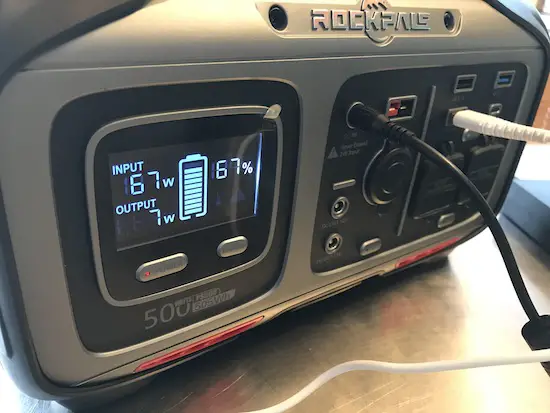For off-grid power, partial home backup power, and even for use with grid power to reduce utility costs, a solar generator is a versatile system with several benefits.
When looking into solar generators, their battery sizes, output power, and solar input capabilities are almost all different from one another. Depending on what you’re powering as well as your solar panel setup, their daily use may come into question.
A solar generator can be used every day, but its duration of use depends on its battery size, power output, solar recharging speed, and what you’re powering with it. A small solar generator can be used daily for recharging devices, while a large system can be used to power your fridge daily.
However, there are additional factors that determine if your appliances and devices can be used with a solar generator daily. This includes:
- Wattage of your solar panel setup
- Available sunlight
- Pass-through charging capabilities
In this post, I’ll be going over all of these points in more detail and discuss some other aspects to consider for using a solar generator on a daily basis. I’ll then give some examples of what certain models can power daily and compare them side-by-side.
If you’re interested in solar generators specifically for powering refrigerators, I have a post that goes over three models that can power full-size refrigerators and compare them to see how long each one will power them for. You can find this post here: 3 Best Solar Generators for Your Fridge (With Run Times).
Can you use a solar generator every day?

As a general rule, most solar generators can power small devices and appliances daily. For powering high-powered appliances, its battery capacity, power output, and solar input should be above average. A solar generator with pass-through charging can also be beneficial for consistent daily power.
There are three elements to review when considering using a solar generator daily:
- Maximum solar panel input – Tells you how much solar it can take in and ultimately how fast it will recharge
- AC power output – Gives you an idea of what you can power with the portable power station
- Battery capacity – Helps you estimate the length of time you can run different appliances before needing to recharge
Using these characteristics, let’s look at three examples of portable power stations with completely different capabilities and see what they can power.
| Model | Goal Zero Yeti 200X | Jackery Explorer 1500 | EcoFlow Delta Pro |
|---|---|---|---|
| Solar Input (Max) | 100W | 500W | 1,600W |
| AC Power Output | 120W continuous, 200W surge | 1,800W continuous, 3,600W surge | 3,600W continuous, 7,200W surge |
| Battery Capacity | 187Wh | 1,534Wh | 3,600Wh |
| What Can It Power? | Smartphone (12Wh): 16 recharges Tablet (30Wh): 6 recharges Laptop (50Wh): 4 recharges Portable Fridge (25W): 8 hrs | Mini cooler (60W): 21 hrs Blender (500W): 3 hrs Coffee Maker (1,120W): 68 min Pressure Cooker (900W): 75 min Microwave (1,000W): 68 min | CPAP (40W): 50 hrs Fridge (120W): 24 hrs 50" TV (110W): 27 hrs Microwave (1,300W): 2.5 hrs Washer (500W): 6.5 hrs |
Depending on your power requirements, you might be able to power some of your devices/appliances every day with a solar generator. But an important piece of the puzzle here is how long it will run these items for before needing recharging.
How long can a solar generator run?

A solar generator can run from less than an hour to an indefinite period of time depending on its input/output power, battery life, and the devices/appliances you’re using with it. Solar generators come in several different sizes with varying output capabilities.
For example, we can use a simple 11W LED light and pair it with a solar generator’s battery capacity to estimate how long the light will run.
Using the same three models mentioned previously, you’ll notice the differences are drastic.
| Model | Battery Capacity | Est. Run Time w/ 11W LED Light |
|---|---|---|
| Goal Zero Yeti 200X | 187Wh | 17 hours |
| Jackery Explorer 1500 | 1,534Wh | 139 hours |
| EcoFlow Delta Pro | 3,600Wh | 327 hours |
Below are some additional devices and appliances along with running times for these three portable power stations.
| Model/Device | Goal Zero Yeti 200X | Jackery Explorer 1500 | EcoFlow Delta Pro |
|---|---|---|---|
| Smartphone (11Wh) | 15 recharges | 127 recharges | 313 recharges |
| Car Fridge (60W) | 2.8 hours | 21 hours | 57 hours |
| 50″ TV (110W) | 1.4 hours | 11.5 hours | 27 hours |
| Microwave (1,000W) | N/A | 1.13 hours | 3.24 hours |
| Hairdryer (1,600W) | N/A | N/A | 2 hours |
From the table, you can see that basic devices and small appliances have vast differences in running times depending on the solar generator model. It’s also important to note that the larger appliances consume a lot of power, however, they aren’t typically used often throughout the day.
That being said, there are still appliances that use power throughout the entire day, such as a fan or a refrigerator. The combination of appliances that use consistent power as well as ones used for small portions of the day (hairdryer, blender, etc.) should be considered when daily use of the solar generator is in question.
When all of your intended appliances and devices are added together in a daily-use estimation, then the solar generator’s battery needs to be big enough to provide you with the power you need. You can use this power consumption calculator from electricaltechnology.org to measure how much energy your appliances consume daily.
from electricaltechnology.org to measure how much energy your appliances consume daily.
Some portable power stations have the option to expand their battery capacities with additional batteries in order to maintain a consistent power output to your appliances. Some of the models that have this are the:
- Point Zero Energy Titan
- Bluetti AC200P & AC200MAX
- EcoFlow Delta Pro
- Goal Zero Yeti 3000X
- Nature’s Generator Powerhouse
In addition to a large battery, the ability to charge the solar generator while using it improves its eligibility for daily use. This is called pass-through charging, and it allows you to continue powering needed appliances during the day while the battery simultaneously recharges. Ultimately, this gives you more battery life for use throughout the night.
Can I charge a solar generator while using it?

Most solar generators allow pass-through charging. Smaller ones, like the Rockpals 500, only allow you to use its DC ports when recharging, while larger models tend to allow the use of their AC and DC ports when recharging. Pass-through charging can overwork the battery due to excessive heat.
However, if you’re using a power station with a large battery for pass-through charging, it may be able to handle heat better than a smaller model.
For example, if you’re using a large solar generator like the Titan to power your fridge while it’s recharging from solar, it should be able to work without issues. This is because the refrigerator only uses about 100-300W of power when running, which is not a lot of energy when considering the Titan’s battery size (2,000Wh+) and maximum power output (3,000W continuous).
The problem comes when you intend to use a solar generator to its limits while also recharging it to its limits. This is not recommended because it creates excessive heat. This heat may not affect the system when using it initially, but it ultimately can affect the cycle life , or longevity, of the solar generator’s battery.
, or longevity, of the solar generator’s battery.
Conclusion
There are several portable power stations that allow pass-through charging. I recommend reviewing product manuals and FAQ pages of solar generators you’re interested in to check for this feature.
However, the best method is to get a solar generator with a battery that’s big enough to power what you need without needing to use pass-through charging often.
If using your solar generator daily is a must, then getting one fitted to your needs is vital for consistent power. I have some other blog posts that can steer you in the right direction depending on what you intend to use your solar generator for below:



